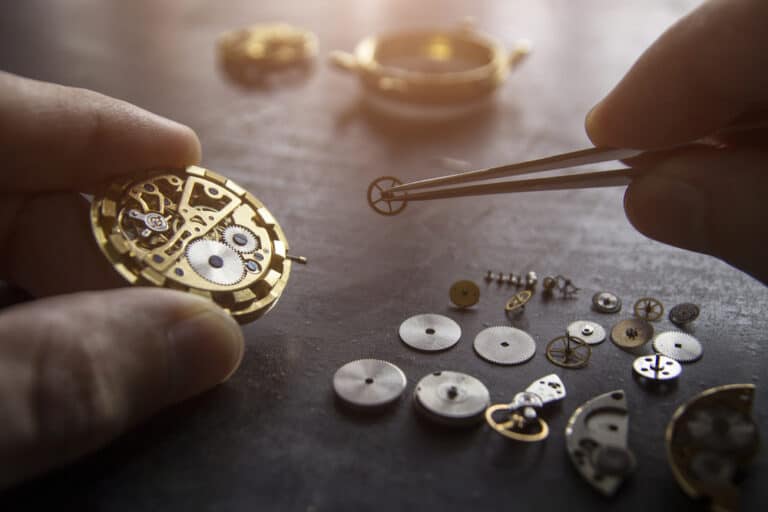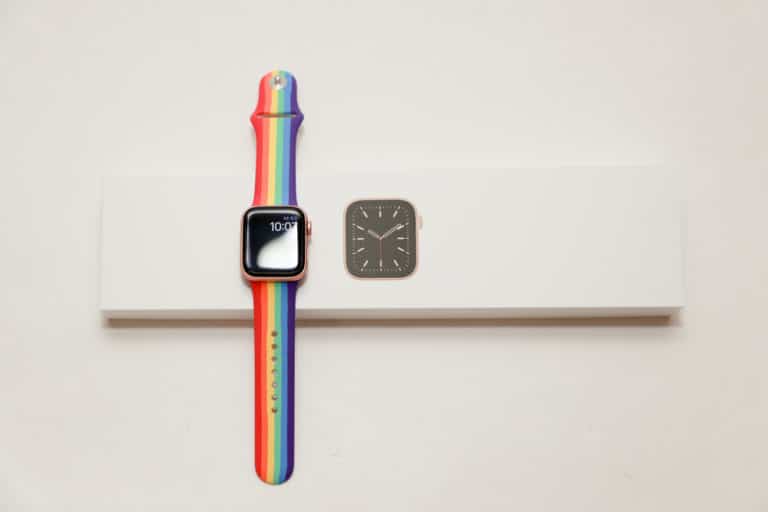The electronic digital wristwatch became available in 1972. Back then, the wristwatch retailed for an outrageous $2,100. Fortunately, towards the end of the 1970s, the price dropped below $10. In the 1980s, it was common to find these watches in cereal boxes.
Digital watches are powered using low-frequency quartz crystals. The crystal quartz gets an electronic charge from the battery via an electronic circuit; this makes the oscillator vibrate quickly at 32,768 times per second. The circuit tracks the vibrations sending out one-second electric pulses, making the watch’s hands spin.
Digital watches keep time using a crystal; there is no ticking mechanism; it is a battery-operated watch. A silicon chip inside a digital watch detects the vibrations of the quartz crystals and converts this into pulses; the pulses are displayed as numbers on the liquid crystal display (LCD) on the face of the watch.
The History Of The Digital Watch
The first digital mechanical pocket watches were produced towards the end of the 19th century; by 1920, the first digital mechanical wristwatches emerged. Digital watches display the time using digits. A mechanical digital watch is powered by a mechanical movement, whereas a digital watch is powered electronically.
Cortebert, a French company produced the ‘jump hour’ pocket watch en masse in the 1890s; The ‘jump hour’ wristwatch went into production in the 1920s. A ‘jump hour’ watch is named because the hour hand jumps between hour markers. The ‘jump hour’ watches re-appeared in the 1970s.
Jump watches are unique and have interesting designs; they are held in high regard; recently, they are making a come-back because of their uniqueness. Some popular jump watches include the tribute Pallweber Edition, the C1 Grand Malvern, and the NAVI x POPEYE.
The Pulsar LED prototype was the first digital electronic watch created in 1972 by the Hamilton Watch Company and Electro-Data. The inspiration for the watch came resulted from the 1968 science fiction movie ‘2001, A Space Odyssey’. It retailed for $2,100 and had a red light-emitting diode (LED) display; it was 18k gold. This watch cost more than a high-end Rolex did at that time.
Digital LED watches were extremely expensive; most people could not afford to buy them. In 1975 they became more affordable when Texas Instruments mass-produced watches in plastic cases. The watches were eventually sold for $10 each in 1976. In the process, the Pulsar brand lost $6 million and was forced to sell to Seiko.
Watch-wearers press a button to see the time on an LED display. The liquid crystal display (LCDs) replaced the LED display in 1973, produced by Seiko. Because LCDs use polarized light, it wasn’t easy to read the display if a watch-wearer wore polarized sunglasses.
After 1980, digital watch technology improved dramatically. Examples of technological advances include the Seiko TV watch, which had a built-in television screen, and a watch with a thermometer produced by Casio. In 1985, Casio also produced a watch that could translate 1,500 Japanese words into English. The CFX-400 scientific calculator watch originated in 1987.
The Power Source of Digital Watches
Digital watches are an important piece of technology, largely now replaced. Several components in a digital watch; include the power source, the crystal oscillator, the counter, and the LED display. The watch battery is connected directly to a crystal oscillator.
The power from a digital watch can either come from a battery cell or AC power. AC-powered digital watches are fixed in one place and are not meant to be moved around. The advantage of AC-powered watches is that they don’t require battery changes as they are plugged into a wall socket.
The AC-powered watch or clock is larger than a wristwatch and therefore needs more electricity than a battery cell can produce. Battery-powered watches need to be replaced from time to time and can only power smaller-sized watches. A major advantage of the battery-powered watch is its mobility.
How A Digital Watch Keeps Its Time
The oscillator is used to generate the timing signal; this signal correctly counts seconds, minutes, and hours; oscillations are generated by embedding the crystal in a feedback loop. The oscillator creates a 60-hertz signal; each hertz represents one oscillation per minute. An oscillator’s job is to keep the time in a watch.
How Digital Watches Displays The Time
The crystal oscillator sends a time base signal through a counter; the counter breaks up the time base by doing division calculations, first by ten, then by six. The clock then starts counting the seconds; the time is then accurately displayed.
Once accurately displayed, the resultant binary number is sent to a microchip; the microchip is programmed to convert this binary number into a set of seven numbers, which correspond to the hours, minutes, and seconds of the current time.
After the microchip converts the binary number into the correct time, this is displayed through the LED lights. Whenever the microchip processes the next set of numbers, it is displayed on the LED.
A Digital Watch Will Lose Time
Digital watches can lose or gain time because of temperature and air pressure. In warmer air, the quartz crystal will oscillate a bit quicker than 32,768 times per second; this factor will lead to a digital watch running a bit faster.
Colder air will have the opposite effect, and fewer oscillations result, meaning the watch will run slower. In general, digital watches can gain or lose around 20 seconds per month. The loss or gain of a digital watch is much smaller than that of a mechanical watch movement.
Digital Watch Lifespan
A modern digital watch battery will last at least two years, sometimes even longer. Using the additional features of the watch can affect the battery’s lifespan; features include alarms, timers, and calculators.
Some digital watches are solar-powered; they don’t need battery replacements as they can be powered by any light source and can operate for months before recharging. The cell of a solar-powered battery may degrade quicker if the battery isn’t used.

Conclusion
Digital watches are powered by a low-frequency quartz crystal charged by a battery; the oscillator vibrates, pulses are sent to a counter, and a microchip converts the time to the LED display. The digital watch has the advantage of having no moving parts; they are more economical than analog watches and extremely accurate.
References
- https://electronics.howstuffworks.com/gadgets/clocks-watches/digital-clock1.htm
- https://oureverydaylife.com/columbia-sportswear-watch-instructions-12497763.html
- https://www.pcmag.com/news/the-digital-watch-a-brief-history
- https://watchfriendly.com/how-do-digital-watches-keep-time/
- http://www.uniquewatchguide.com/mechanical-digital-watches.html







